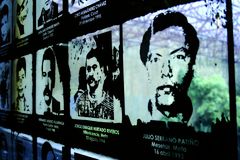Article published in the special Newsletter '15 years of PBI', October 2009
Carlos M. Beristain, Psycho-Social support (1996-2003)
From a place of fear and pain, resistance and support, these stories speak, reflecting pieces of Colombia and ourselves.
Fifteen years ago we came to Colombia. At that time, with the Colombia project and the accompaniment to be done by PBI, the beginning of an enormous challenge could be felt. We also sensed it in the part of the stomach where fear is felt. By psycho-social support, we refer to the reconstruction of social fabric since it means accompanying and opening spaces to re-weave stories, people and lives. In this work, we learned a lot about people, where the workshops, meetings, and support spaces we created opened themselves up little by little to become new processes, organisations, and challenges.
The Women
The OFP women weave together services, meetings, trainings, and support. These women also have a network of community kitchens in Barrancabermeja. Today we will eat in one of them. Ana and Josefa cook for the families that have children in school, for the people that cannot buy groceries because they are just trying to survive. Everyday, they perform the miracle of loaves and fishes. After everyone has gone, they satiate their own hunger, wash the pots and pans, and settle the accounts with simple arithmetic. The pennies left over from every kitchen depart in the afternoon and return to where they came from in the form of medical assistance, workshops, and services.
Returning to Urabá
We got on the chiva bus for San José de Apartadó. It was a bus taken out of some colourful story. In the midst of the bananas and the jungle, the chiva travels as best it can. Outside there is noise. Salsa and vallenato fight it out on the corners and fill the chiva from both sides, just like the people that board the chiva as it begins to move. There is a huge ruckus, almost as big as the silence here within. We come to a paramilitary checkpoint. A young man with a frigid stare stops the bus and two other men come up on the sides. Eyes looking at faces, but not at eyes. Glances are not even traded. After a while, which should not have been even three minutes according to my watch, and after returning the keys to the driver and talking endlessly on the radio transmitter, after one’s breathing is reduced to short, little breaths, they leave.
Memory Gallery for the Disappeared
The room is full of transparent faces hanging from the ceiling by a string as faint and strong as the memories. The photos hang at the height of a face. Entering here, one perceives an air of respect. Some would say that it is something mystic, almost religious. For me, this silence is something else. It is a part of what family members of the disappeared carry inside them. For that reason, this gallery is not just an exposition. It invites accompaniment. In the presentation Gladys explains that the gallery is full of faces, not just to put a name or color to their memory, nor provide a place for their losses. She wants the people who see it to ask: «How do the families get through each day? Where are they?».
The Ball and Indigenous People
They explain the conflict as if it were a football match. On the one side are the community project and all the activities planted and cared for in the midst of war. On the other side are the conqueror, the landlord, and those who kill and divide us. It is a game of strategy. The resistance is not only to the armed conflict. They look even farther: it means defending the life project. Later, someone finishes the explanation at the centre of the issue: the ball, the dispute, is our land.
In the Midst of Combat

